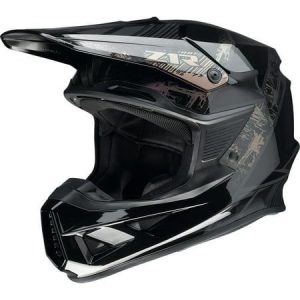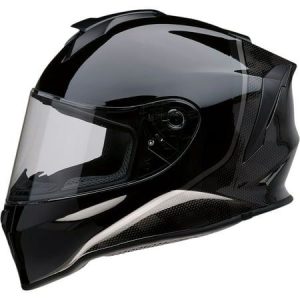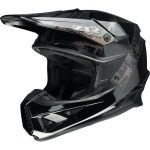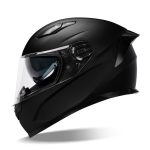A motorcycle helmet is your essential safety gear. It’s the sole barrier protecting your head in a crash, making proper fit absolutely crucial. A helmet that’s too loose can move around during an accident, reducing its effectiveness. Conversely, a helmet that’s too tight can be uncomfortable and lead to headaches, potentially compromising focus while riding.
This comprehensive guide explores how a motorcycle helmet should fit, providing essential tips to ensure optimal safety and comfort on every ride. We’ll delve into the importance of a snug fit, proper cheek pad pressure, and the various tests to guarantee your helmet stays securely in place during any situation.
The Importance of a Snug Fit: Your Helmet’s Secure Embrace
The most important aspect of helmet fit is snugness. The helmet should feel comfortably secure on your head, with minimal movement when you shake it gently from side to side. Here’s why a snug fit is paramount:

- Enhanced Protection: In a crash, a properly fitted helmet absorbs impact by distributing the force across its shell. A loose helmet can rotate or come off completely, significantly reducing its protective capabilities.
- Reduced Wind Noise: A loose helmet allows wind noise to enter, creating distractions and fatigue during rides. A snug fit minimizes wind noise, promoting a more comfortable and focused riding experience.
- Improved Stability: A secure helmet minimizes movement, enhancing head stability and reducing neck strain on long rides.
Remember, a snug fit doesn’t equate to being uncomfortably tight. The helmet should feel secure but not constricting, allowing for slight head movement without compromising overall stability.
The Cheek Pad Test: Finding the Perfect Pressure
Cheek pads play a vital role in achieving a snug helmet fit. Here’s how to use the cheek pad test to ensure optimal pressure:

- Put on the helmet without fastening the chin strap.
- Wiggle your head from side to side. The cheeks should feel firm pressure from the pads, but you shouldn’t experience any pinching or discomfort.
- Try to pull the helmet off your head straight up. A properly fitted helmet with good cheek pad pressure will resist being pulled off easily.
Some helmets come with replaceable cheek pads in different thicknesses. If the initial fit feels too loose or too tight, consider visiting a qualified motorcycle gear store to explore alternative cheek pad options for a personalized fit.
The Chin Strap Test: Securing the Vital Connection
The chin strap is another crucial element ensuring a secure helmet fit. Here’s how to test proper chin strap tightness:
- Fasten the chin strap snugly.
- Try opening your mouth as wide as possible. The helmet should feel slightly tighter, but not restrict your ability to speak comfortably.
- Gently try to roll the helmet forward on your head using the chin strap. A properly secured helmet should resist this movement.
Remember, a loose chin strap can render the helmet ineffective in a crash. Always ensure the chin strap is fastened securely before every ride.
Beyond the Tests: Additional Signs of Proper Motorcycle Helmet Fit
While the tests mentioned above are valuable tools, here are some additional indicators that your helmet fits correctly:

- No Pressure Points: The helmet should not create any pressure points on your forehead, temples, or jaw.
- Neutral Head Position: Your head should feel naturally positioned within the helmet, not tilted forward or backward for comfort.
- Visor Seal: The visor should close completely and form a tight seal against the helmet shell to prevent wind noise and debris ingress.
If you experience any discomfort or difficulty performing the tests mentioned above, it’s best to consider a different helmet size or consult a motorcycle gear expert for further assistance.
The Shape Matters: Selecting a Helmet for Your Head Shape
Not all heads are created equal, and neither are motorcycle helmets. Helmet manufacturers design helmets to cater to different head shapes. Here’s a brief overview:
- Oval: This is the most common head shape, and most motorcycle helmets are designed with an oval fit in mind.
- Round: Round heads are slightly wider than they are long. Look for helmets labeled “round fit” or consider adding cheek pads to achieve a snugger fit with an oval helmet.
- Long Oval: Long oval heads are longer from front to back than they are wide. Some manufacturers offer helmets specifically designed for this head shape, or you might find success with a slightly larger oval helmet.
If you’re unsure about your head shape, a qualified motorcycle gear salesperson can assist you in determining the best fit based on head measurements and trying on different helmets.
The Break-In Period: Allowing Your Motorcycle Helmet to Conform
New motorcycle helmets often feel slightly snug during the first few rides. This is because the helmet’s inner liner needs time to conform to the shape of your head. The break-in period typically takes around 15-20 hours of riding, and the helmet should gradually become more comfortable while maintaining a secure fit.

Important Note: If the helmet feels excessively tight or uncomfortable even after the break-in period, it’s likely not the right size for your head. Don’t attempt to break in a helmet that doesn’t fit properly.
Safety First: Replacing Your Motorcycle Helmet When Necessary
Motorcycle helmets, like any safety gear, have a finite lifespan. Here’s when it’s time to replace your helmet:
- Visible Damage: Cracks, deep scratches, or any signs of structural compromise necessitate immediate helmet replacement.
- Age: Even if a helmet appears undamaged, replace it after 5-7 years due to the natural degradation of the materials used in its construction.
- Crash Involvement: A helmet involved in a crash, even a minor one, should be replaced. The impact can compromise the helmet’s protective capabilities, even if there’s no visible damage.
Remember, your motorcycle helmet is your primary defense in a crash. Don’t hesitate to replace it if there’s any question about its safety or integrity.
Choosing the Right Motorcycle Helmet for Your Riding Style: Safety and Comfort in Harmony
Now that you understand the importance of proper helmet fit and various factors to consider, it’s time to explore how riding style influences helmet selection. Here’s a breakdown of popular motorcycle helmet types tailored for specific riding disciplines:

-
Full-Face Helmets: Offering maximum protection, full-face helmets enclose the entire head, face, and chin. Ideal for sport riding, touring, and commuting due to their superior safety features, including a visor for wind and debris protection.
-
Modular Helmets: Also known as flip-up helmets, modular helmets offer the versatility of a full-face helmet with the convenience of a flip-up chin bar. Popular among touring riders, modular helmets allow for easy on and off while providing full-face protection when closed.
-
Open-Face Helmets (¾ Helmets): Prioritizing comfort and a wider field of view, open-face helmets expose the face. Suitable for relaxed cruising at slower speeds, but not recommended for highway riding or aggressive riding styles due to reduced protection.
-
Half Helmets (Skullcaps): Offering minimal protection, half helmets cover only the top and back of the head. Legal restrictions for half helmets vary by state, and their safety limitations make them a less popular choice among safety-conscious riders.
-
Dual-Sport Helmets: Designed for both on-road and off-road riding, dual-sport helmets often come with a peak visor for added protection against dirt and debris. They typically have a wider field of view than full-face helmets to enhance off-road visibility.
Selecting the right helmet goes beyond style. Prioritize safety by choosing a helmet that offers the necessary protection level for your riding style.
Selecting the Right Motorcycle Helmet for Your Riding Style!
In the next section, we’ll delve into different motorcycle helmet types designed for various riding styles, from sport riding to touring and cruising. Stay tuned to ensure you find the perfect helmet that offers optimal safety and comfort for your riding needs!


